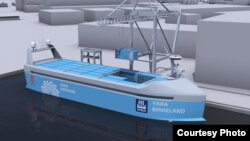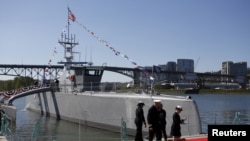Driverless technology will soon enter another major global industry: shipping.
Several companies recently announced plans to launch self-sailing ships to improve safety and efficiency.
One of them is Norwegian chemical company Yara International. Yara has teamed up with another Norwegian company, Kongsberg, to build an autonomous cargo ship expected to launch next year. Kongsberg developed the ship’s electrical technology and autonomous control systems.
The ship is fully electric to reduce air pollution. It is designed to carry cargo containers normally transported by truck. This means the ship will also improve road safety by replacing about 40,000 truck trips a year, the company said.
The ships will be transporting shipments from Yara’s main production plant to two ports where its materials are shipped to cities around the world.
The company plans to operate the ships by remote control beginning sometime next year. By 2020, the ships should be loading and sailing themselves. While Yara’s ships will be limited to Norway at first, the company plans to greatly expand its autonomous shipping operations in the coming years.
Another company putting a high priority on self-sailing ships is the world’s largest mining company, Australia’s BHP Billiton. The company’s Vice President of Freight, Rashpal Bhatti, recently spoke about the technology in a website post.
Bhatti said he believes automation will be one of the biggest changes for shipping in the future. “Autonomous vessels offer significant opportunities to improve safety and provide better efficiency outcomes to the marine supply chain.” He added that self-sailing ships could become a reality within the next decade.
Rolls-Royce, the British engineering company, is also developing unmanned shipping technologies. Oskar Levander is the company’s head of marine operations. He told a conference last year, “This is happening. It’s not if, it’s when.”
Levander said these autonomous ships could be controlled by remote operators from anywhere. He added that because these ships will be designed to be unmanned, they can be built smaller, more efficient and environmentally friendly.
In Japan, several shipping companies have invested hundreds of millions of dollars to develop self-sailing ships expected to hit the high seas by 2025. These ships will be equipped with technology to collect weather and sea data. They will then use the data to plan out the safest, shortest and most fuel-efficient route.
Autonomous ships have also been developed for military use.
Last year, the U.S. Navy introduced a warship that can direct itself and be used to hunt enemy submarines. The 40-meter-long vessel is called Sea Hunter. It is powered by two diesel engines and does not carry weapons.
Sea Hunter can sail for two to three months without a crew. It can operate at a cost of between $15,000 and $20,000 per day, far less than the amount required to run manned ships.
I’m Bryan Lynn.
Bryan Lynn wrote this story for VOA Learning English. Hai Do was the editor.
We want to hear from you. Write to us in the Comments section, and visit our Facebook page.
Editor's Note: The company Rolls-Royce in this article is an engineering company which makes engines for, among other things, aircraft. It is not related to automobile manufacturing as stated in an earlier edition.
________________________________________________________________
Now, test your understanding with this short quiz.
________________________________________________________________
Words in This Story
efficiency – n. capability to produce desired results without wasting materials, time, or energy
cargo – n. something carried from one place to another
remote – adj. happening from a distance
priority – n. something more important than other things that needs to be done or dealt with first
automation – n. running of something by machines, computers, etc, instead of people
marine – adj. of or relating to the sea
route – n. way to get from one place to another











